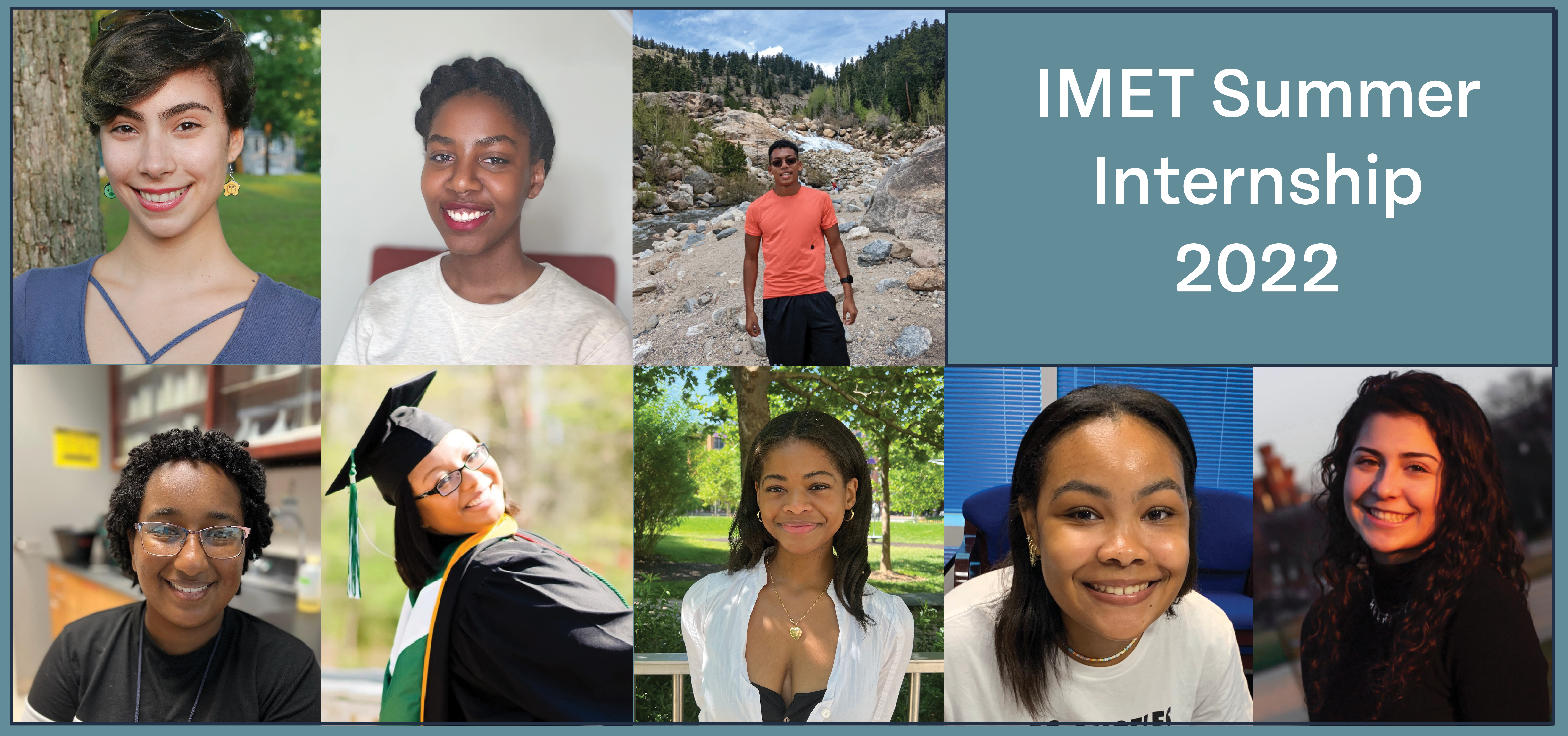Week 1: Activate Your Voice
On June 6th, IMET’s labs and hallways got a little busier and brighter. The summer has started which means, IMET has welcomed a new cohort of undergraduate interns within its tented roofs. As this is the 21st year of IMET’s Summer Internship we probably don’t have to explain… but, for all the newcomers, we’ll give a quick rundown.
IMET’s Summer Internship provides opportunities for students from underrepresented backgrounds in science to get hands-on research experience in the fields of marine and environmental science. Each intern works with, a “PI” or “Principal Investigator”, on a specific research project. These projects fall under one of IMET’s three research areas: Sustainable Aquaculture Production; Environment, Animal, and Human Health; or Energy and Climate Change. While the internship is science focused, our interns gain a broader experience by attending multiple seminars, trainings, and workshops throughout the summer, including a weekly Friday session with various speakers and activities.
Oh, one other thing I should mention, if you have followed IMET's Summer Internship Program you will know that Dr. Rosemary Jagus has led this program for the last 20 years. This year she passed the directorship on to IMET’s, Dr. Eric Schott. Never fear, you will still get to read about Dr. Jagus as she is continuing to work with Dr. Schott and will be a PI for one of our interns this year! Let’s give a big congratulations and good luck to Dr. Eric Schott in his first year as Director of the summer internship program! Okay, now that we are all on the same page, let’s see how the first week went for our interns!
Let’s start with day one…orientation. Since most of our interns are staying in dorms at Coppin State University, the day started with a ride on Baltimore’s Metro. With their own street smarts and a little bit of help from Dr. Schott all eight of our interns arrived at IMET bright and early. Introductions happened over breakfast, (we were disappointed we couldn’t invite you too, so we asked our interns to introduce themselves here) the interns got to meet the faculty PIs and graduate student mentors they will be spending the next nine weeks with. As orientation continued, it covered topics such as IMET history, facilities management, security, use of animals, lab conduct and more. These topics brought our students face to face with some more of IMET’s incredible minds: Executive Director Dr. Russell Hill, Faculty Research Assistant John Stubblefield, and administrator Sarah Hughes.
Fast-forward to day two, time for a tour of IMET’s Aquaculture Research Center (ARC) with Dr. Keiko Saito. Dr. Saito led our summer interns through IMET’s state of the art facility, familiarizing them with the systems and species that exist on the ground floor of IMET. The interns were shown the salmon, tilapia, shrimp, and bluegills; as well as the Recirculating Aquaculture System that sustainably supports them.
The rest of the week flew by. Each intern spent the remainder of week-one with their PIs and mentors learning more about their lab and research project. It wasn’t until Friday, that we all met again, this time with a special guest.
You must remember, while this internship is focused on science, it is also meant to support students whose backgrounds have not always been celebrated, welcomed, or even allowed in the field of science. While we work to change this, we must recognize and attempt to understand the impacts this has on not only our institutions but each individual person. We are so grateful to once again have Keith Snipes join our summer internship program as a presenter and mentor. Keith is a Baltimorean actor and vocalist. As a Shakespearean actor, Keith has his own experience of what it means to be black in a primarily white workforce. Keith’s experience as a black man, an actor, a poet, a vocalist, and a fellow person living through the trials of today makes him an excellent mentor for our interns.
Upon introducing himself, Keith let our interns know that he is here to help them “activate, develop, and animate their voice”. To do this, Keith asked everyone to reflect on current events. In a work environment, this topic can sometimes be viewed as taboo. However, for our interns and those of us sitting in the room, this was quite relieving. We are living through so many frightening and historic events, it is difficult to continue living normally when everything around us feels so uncertain. With Keith, the interns discussed topics such as the January 6th Insurrection and ongoing hearings, as well as the Supreme Court Roe v. Wade leak. Feelings of fear, betrayal, frustration and helplessness permeated these conversations. However, our interns inspired us with their hope and determination for a better future. They expressed the importance of language and the duty that those with privilege have to challenge hateful ideas. Afterwards, they said it was boosting to have an opportunity to speak openly about contentious issues.
Keith inspired further with his incredible reminder that, there will always be fear, but this fear can be overcome with purpose- “your purpose is stronger than your fear”. I guess those beautiful words feel like a great place to close out week-one. Thank you so much for joining our interns on this journey and we look forward to sharing week two with you!
Week 2: Feeling Like a Scientist
Week two started with an exciting day at IMET. Daniela Tizabi, a PhD student in the lab of Dr. Russell Hill defended her PhD dissertation. Daniela’s research focused on the search for novel anti-tuberculosis drugs. Specifically, Daniela explored the possibility of using bacteria found in the Caribbean giant barrel sponge to inhibit the growth of Mycobacterium tuberculosis.
Joining Daniela’s committee and about 50 audience members, the interns got a first hand look at the reality of graduate school. Daniela’s six years of study, research, and writing culminated in this moment. The interns watched as she delivered an impressive summation of her research and its findings. At the conclusion of her presentation, everyone at IMET, including the interns, returned to work; however, Daniela and her committee remained. Asking questions and conversing, the committee took an allotted two hours to deliberate on Daniela’s dissertation. After this time had concluded, the committee declared that Dr. Tizabi had successfully defended her PhD dissertation. We can’t help but wonder if any of our interns will one day go through this very same process? Wonderings aside, we were happy to see the interns join in the afternoon celebration.
With more experience under their belt and their confidence growing, the rest of the week passed quickly for our interns. Although they don’t have official project titles yet and many are still learning their lab procedures, we finally got a quick glimpse into some of the interns' work!
Engineering student, Eric Sibanda shared that he and his mentor, graduate student Matt Stromberg, have been collaborating on the final design of a filtration system to remove “off flavors” in aquaculture raised salmon. Geosmin, a metabolite of certain bacteria, gets absorbed into salmon raised in Recirculating Aquaculture Systems giving them an earthy taste. Typically it would take an extreme amount of flowing water to remove these “off flavors”. However, the filtration system Matt and Eric are working on could decrease the amount of water needed to remove them, saving water and making your fish taste better!
Libby Gilmore, working with Dr. Allen Place and Dr. Ernest Williams, is looking at the effects of adding aragonite (a natural and renewable form of calcium carbonate from the ocean) to chicken litter. Specifically, Libby is analyzing the change in bacterial diversity after the mineral, aragonite, has been added to the bedding. This research is working to prove the effectiveness of aragonite on the reduction of ammonia gas released from chicken houses. Ammonia is a greenhouse gas that is toxic at high concentrations. When the aragonite is mixed into the bedding of chickens, it is believed that the water available to the bacteria living there is reduced which results in a change of bacterial community. This changes the communities of bacteria able to survive in the litter. As these communities change, it is hypothesized that the bacteria remaining can no longer break down uric acid into ammonia leading to the decreased release of ammonia gas.
Zoma Atnafou is working with Dr. Eric Schott to analyze bacteria living in Baltimore’s Inner Harbor and explore their relationship with the local mussels. This week Zoma and a group of interns went out to collect water samples and mussels from the harbor. Working with Dr. Khaled Geba, a visiting professor in the Schott laboratory, Zoma started collecting from a location just outside of Baltimore’s National Aquarium. While Dr. Geba and Zoma were hard at work, a curious tour group from the aquarium started watching from behind. Upon noticing, Dr. Geba encouraged Zoma to explain their research to the onlookers. Zoma described their work to a group of more than 20 people. Zoma told everyone, in that moment she “felt like a scientist”!
After the interns finished sharing, Keith Snipes began his second session. Last week Keith had asked each intern to research a scientist who inspires them. He encouraged the interns to choose someone they related to. As we are growing accustomed to our interns' resourcefulness, their responses did not disappoint. The group of scientists presented were incredibly diverse and inspirational.
Zoma presented on Rosalind Franklin, the uncredited female scientist who proved the helical structure of DNA. Julia Moya presented on Steve Irwin, the infamous “Crocodile Hunter”, emphasizing his true dedication and enthusiasm for the natural world. Emma focused on Dr. Young Ta Kim, skateboarding scientist turned video game developer with an unconventional approach to science. Jacqueline Rogers, didn’t surprise anyone when she took the unconventional route on this project. Jackie did not pick one inspirational figure but wrote about all who came before her saying, “It’s hard for me to imagine how one woman alone or one minority alone, has paved the way for me to be where I am now.” If you want to see who else inspires our interns and learn a little bit too, you can read about each inspirational scientist HERE.
With Juneteenth approaching, Keith focused the end of the session on freedom- asking the interns what freedom means to them. They had a wonderful discussion about the balance of personal choice and social duty. A lot of their focus was on the interdependence of people and how that impacts freedom. They argued that although we have freedom to do what makes us happy, others have the freedom to hinder our happiness, which is why we need to give every individual the space and respect they deserve. When that happens, we can truly seek optimal freedom and happiness. To conclude this incredibly insightful conversation, Keith performed a poem he wrote entitled, Jazz in June Jubilee. This beautiful poem was inspired by Keith’s love of jazz in the summertime and depicts his heartfelt definition of freedom.
Week 3: The Crustacean Nation
Week three was particularly busy for the interns, they sat in on another graduate student dissertation defense, attended a day-long science communication training, learned more about the LMRCSC program, and participated in Dr. Kate Gillespies’ Poetry-in-Science Workshop. This sounds like a lot, so we’ll break down each of these events for you soon. However, we know you want to learn more about our interns’ research projects too!
The interns are a third of the way through their internship (hasn’t it gone fast?), which means their research projects are beginning to clarify. To give you a glimpse into the interns’ lab experience, we asked them to provide a tentative project title and brief explanation of their work so far. Check out the interns research projects here to learn more about each interns’ research. Keep in mind, research is always evolving. As the internship progresses, watch how these titles and explanations grow and become more refined.
This week began with another successful dissertation defense by one of IMET’s graduate students. Mingli Zhao, a PhD student in the lab of Dr. Eric Schott, presented her defense on Tuesday. Mingli’s dissertation focused on viral diversity across a range of marine ecosystems. She studied the relationship between viral diversity, climate, and host life history. This research utilized Maryland's favorite crustacean, the blue crab, as a result of its wide geographic distribution and susceptibility to viral pathogens. After the successful defense, many of the interns joined Dr. Schott and their IMET colleagues to celebrate Dr. Mingli Zhao.
Attending these defense seminars is a great opportunity to see the importance of clear and effective communication when presenting scientific research. To help develop this skill, our interns gathered for a day-long training with science communicators from IAN, the University of Maryland Center for Environmental Science’s Integration and Application Network. During the session our interns practiced creating conceptual diagrams, using symbols, differentiating between passive and active voice, using color theory, creating posters, presenting powerpoints, and creating “And, But, Therefore” (ABT) statements.
Throughout the training, the growth of the interns’ scientific knowledge and confidence became apparent. They picked up on the training quickly and were able to apply it to their research almost immediately. Each student shared their practice ABT statements and conceptual diagrams, getting positive reviews and constructive feedback. To give you an example, Julia Moya used her “And, But, and Therefore” statement to effectively explain what she is researching, why it is necessary, and how it could impact the community:
"Maryland is improving its sewage waste infrastructure to decrease sewage pollution in the Patapsco River and encourage a healthier environment for marine life to thrive and grow. However, we are still unsure if these improvements are enough to bring more marine life back to the area. To visualize if there has been an increase in the number of species over the years, we can compare DNA codes of sampled marine life from the past and present and determine if there is more variety in the species we see now, or if there are still only the same species we've seen from previous years. This will tell us if the sewage pollution was the main cause for species loss in the area, or if there may be another culprit we have yet to find.”
Next week the interns will meet with IAN science communicators once more, this time to learn about graphic and publishing softwares, Adobe Illustrator and Adobe InDesign.
This Friday’s lunch session included a talk by IMET graduate student Olivia Pares. Olivia is a PhD student in the lab of Dr. Eric Schott, where she studies pathogens in the Atlantic blue crab. Olivia is a National Oceanic and Atmospheric Administration-Living Marine Resources Cooperative Science Center, or NOAA-LMRCSC, Fellow. The LMRCSC program provides support for graduate students from underrepresented groups in marine and environmental science. The goal of this program is to “prepare a diverse student body for careers in marine and fisheries sciences.” All LMRCSC Fellows participate in the NOAA Experiential Research and Training Opportunity (NERTO), which is a “12 week internship at a NOAA lab/facility under the supervision of a NOAA mentor scientist.”
Olivia is currently completing her NERTO at a NOAA laboratory in Puerto Rico. Similar to her research at IMET, Olivia is studying marine pathogens. However, instead of blue crabs, she is working with coral! Certain species of coral are susceptible to a disease called Stony Coral Tissue Loss Disease (SCTLD). Olivia discussed her research on the pathogen that causes SCTLD, her recent scuba diving certification course, and her experience with NERTO.
The final session of week three was Poetry in Science, with Dr. Kate Gillespie. Dr. Gillespie is an IMET alumna, who completed her PhD in the laboratory of Dr. Rosemary Jagus. Dr. Gillespie is an Assistant Professor at SUNY Cobleskill where she works in the College of Agriculture and Technology. A lover of words and poetry, she is also a published poet. To begin her workshop, entitled Poetry in Science, Dr. Gillespie shared a poem she wrote, “Genes get Going”, which you can read here. She then asked the interns to jot down six words: three words “science” makes them think of and three words “poetry” makes them think of. After sharing some examples, Dr. Gillespie asked everyone to write a short poem incorporating their six words. With a symphony of embarrassed giggling, the interns got to work. Watching the supportive and playful interactions taking place during this process gave us a glimpse into the cohesiveness of this cohort.
Before sharing, Dr. Gillespie asked the interns to construct one more poem, this time using an abstract from a scientific paper. The combination of a scientific paper and a poem feels a little contradictory, right? Wrong! Dr. Gillespie showed us that poetry can be found anywhere. By blacking out words in the abstract of a scientific paper you can make poetry. Whether it holds the original message of the paper or creates a whole new story, poems can be made from science writing too! Setting the interns loose with markers, we watched as complex scientific summaries turned into unique, oddly beautiful, forms of poetry.
We know, we can’t sign off without presenting a student written poem. Andrea White wrote an incredible slam poem using her six words from the beginning of the session and agreed to have it published here.
Fresh off the presses! Please enjoy this piece written by, emerging poet, Andrea White:
Thanks so much for tuning in for the third week of our 2022 IMET Summer Internship, catch ya next week!
Week 4: New Guard
Between data collection and lab work, the interns attended two great seminar sessions this week. Once again, the interns met with science communicators from the Integration and Application Network (IAN). The interns also met with Dr. Micah Miles, an Environmental Protection Specialist at FEMA- Federal Emergency Management Agency.
During Wednesday’s workshop with IAN, the instructors provided feedback on last week's homework assignments. One by one, they went through each submitted “ABT” statement. In case you don’t remember, “ABT” stands for “And, But, Therefore”. Last Thursday, the IAN instructors explained that an ABT statement clearly describes scientific research by: setting the stage with background information, presenting the problem, and explaining how research can help create a resolution. Going through the ABT statements, each student was given thorough and well thought out feedback. If you would like to read an example from intern Julia Moya, click here.
After reviewing the statements, the instructors moved on to review the interns’ conceptual diagrams. If you are a visual learner, you will LOVE these! Conceptual diagrams are visual representations of systems. These are usually made with symbols and graphics. IAN teaches the importance of symbols, as they are capable of transcending all languages. After last week's session, the interns used Adobe Illustrator and IAN’s symbol library to create conceptual diagrams for their research projects. Here are a few examples. Can you guess whose diagrams these are based on the descriptions of each intern project?
After providing constructive feedback on the interns’ conceptual diagrams, the instructors gave two Adobe tutorials. Adobe InDesign and Adobe Illustrator are powerful tools for publishing and graphic design. If you have used either, you know how helpful a tutorial like this would be. While difficult to use at first, both applications are extremely worthwhile to learn. The instructors walked the interns through the software’s basic abilities and how to effectively use them. Following along on their computers, the students were incredibly engaged. They raised many questions, asked for clarification, and created their own designs. Finishing up the session, the instructors provided their contact information and encouraged the interns to reach out if they had any questions or needed advice. IAN is an incredible resource and we are grateful for their participation in the IMET Summer Internship.
The last session of the week was with Dr. Micah Miles. You may remember Dr. Miles from last year, when she discussed her experience as Environmental Program Manager for the Waterfront Partnership. This year Dr. Miles has taken on a new position with FEMA, as an Environmental Protection Specialist. Dr. Miles discussed her journey into this field. Growing up she loved nature and was convinced that one day, she would save the entire rainforest. This love for the natural world continued on through her education and career. After completing her undergraduate degree, she gained work experience in several internships and jobs. These experiences brought her focus to urban ecology. It was then that Dr. Miles decided to go to graduate school at the University of Georgia. After applying and being selected for the National Science Foundation Graduate Research Fellowship Program (NSF GRFP), Dr. Miles decided to get a PhD as well as a masters degree.
Dr. Miles gave incredible advice as she shared her story. She encouraged the interns to continue seeking out internships and opportunities. Explaining that, even the opportunities we dislike teach us what we don’t want, which is important for learning what we do want in the future. Convinced she was going to be a vet, Dr. Miles took on an internship in a veterinary clinic and soon learned this was not something she wanted to pursue. Despite this disappointing discovery, Dr. Miles’ stressed the importance of the experience.
Dr. Miles also shared her experience as a black female scientist. She explained that working in rural areas during the time of Freddie Gray’s murder helped solidify her decision to work in the field of urban ecology. She encouraged the students to consider themselves, their comfort, their realities, their goals, and their desires before taking the first job offered to them. Despite the stress that comes with searching for a job, we have to remember that our jobs must serve us and not just the other way around. When asked if she is ever afraid of being bored in a position, Dr. Miles said “absolutely”. But she also shared that being bored can teach us more about who we are, what we want, and what we need. She explained that there is always time to reevaluate and that is a wonderful thing to do.
Dr. Miles closed out her talk by raising her hope for the future. She believes that leaders from her generation (and the interns’ generation) will soon be stepping forward to replace the “old guard”. She believes this “new guard” has the potential to bring about great change.The IAN instructors began their workshop with a famous EO Wilson quote and we thought it might be a good way to close out this week's blog.
"We are drowning in information, while starving for wisdom. The world henceforth will be run by synthesizers, people able to put together the right information at the right time, think critically about it, and make important choices wisely.”
We hope these sessions and experiences will help our interns move forward in the world as synthesizers. Dr. Miles’ expectation of the “new guard” is giving us great hope for the future and we can’t wait to see what comes next!
Week 5: Water Watchdogs
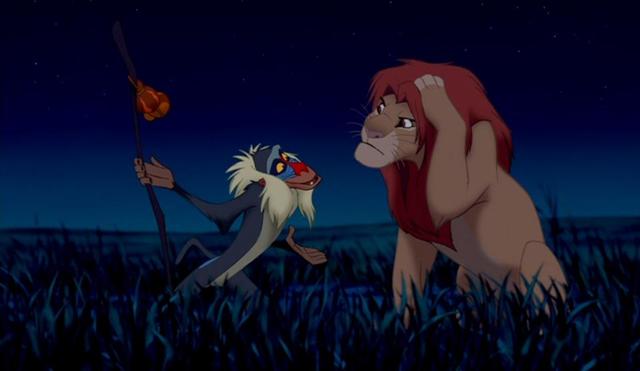

Blog 6: Fish Bones
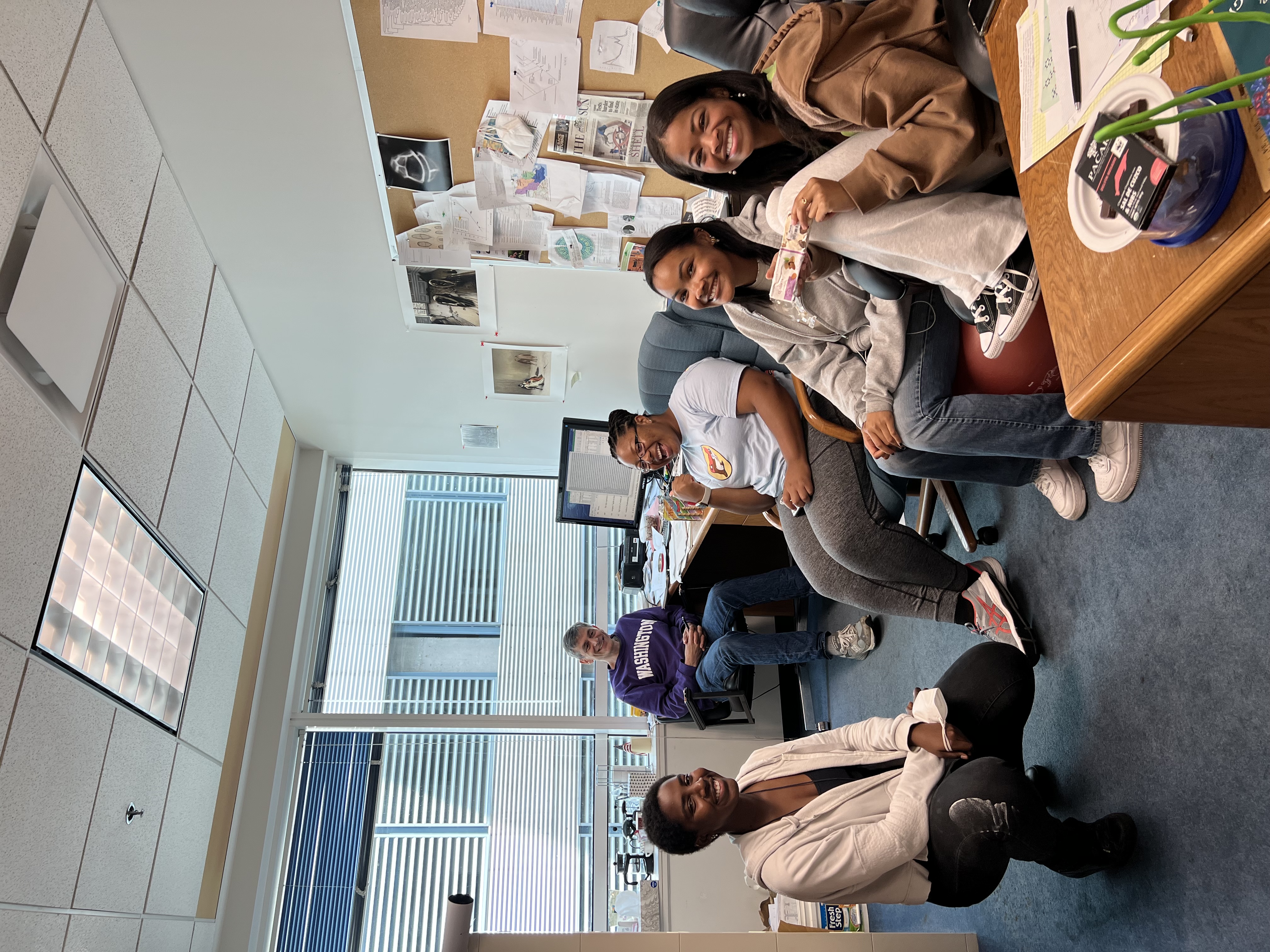
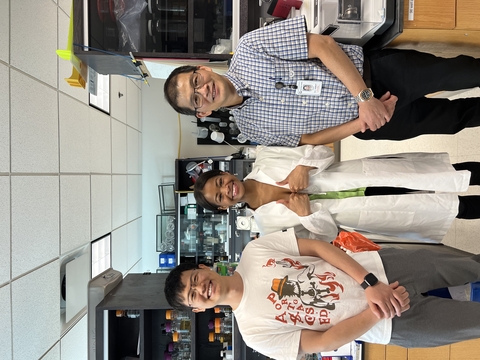 Lan Xu is a PhD student in the lab of Dr. Ten-Tsao Wong. Over the past weeks, Lan has not only prepared for his dissertation defense, but assisted intern Jacqueline Rogers in the lab. Lan’s research focused on the production of reproductively sterile fish. Undesired reproduction is a major concern in aquaculture both ecologically and economically. Producing sterile fish could prevent any escaped aquaculture fish from passing on unfit genes to the wild population and decrease reproduction-related mortalities in aquaculture stocks. Jacqueline Rogers’ research project is focused on the same idea, you can read more about her project here.
Lan Xu is a PhD student in the lab of Dr. Ten-Tsao Wong. Over the past weeks, Lan has not only prepared for his dissertation defense, but assisted intern Jacqueline Rogers in the lab. Lan’s research focused on the production of reproductively sterile fish. Undesired reproduction is a major concern in aquaculture both ecologically and economically. Producing sterile fish could prevent any escaped aquaculture fish from passing on unfit genes to the wild population and decrease reproduction-related mortalities in aquaculture stocks. Jacqueline Rogers’ research project is focused on the same idea, you can read more about her project here. 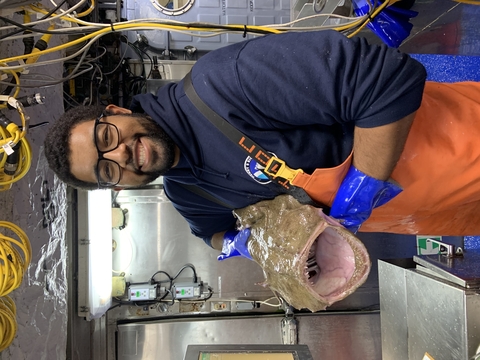
Week 7: An Elite Team
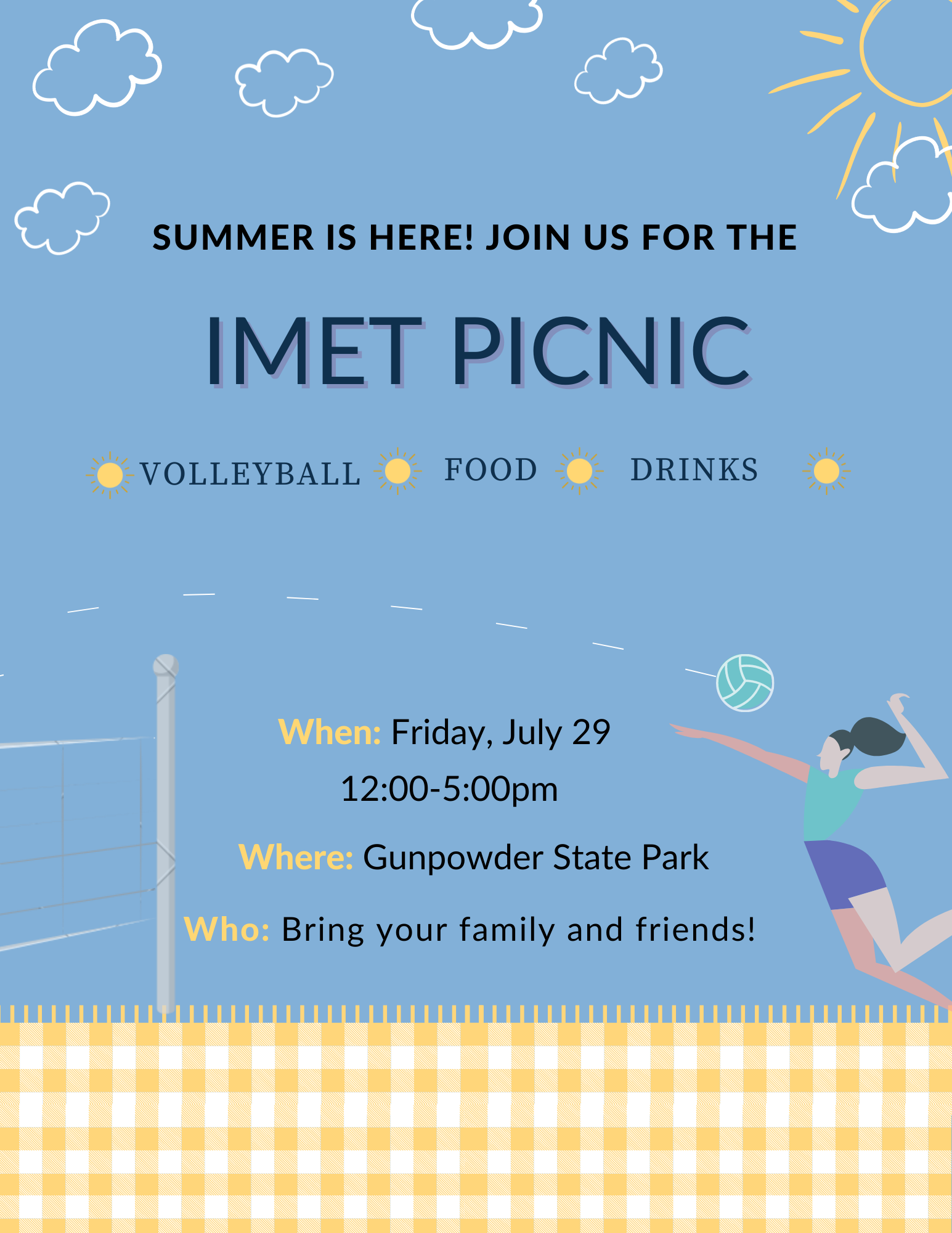
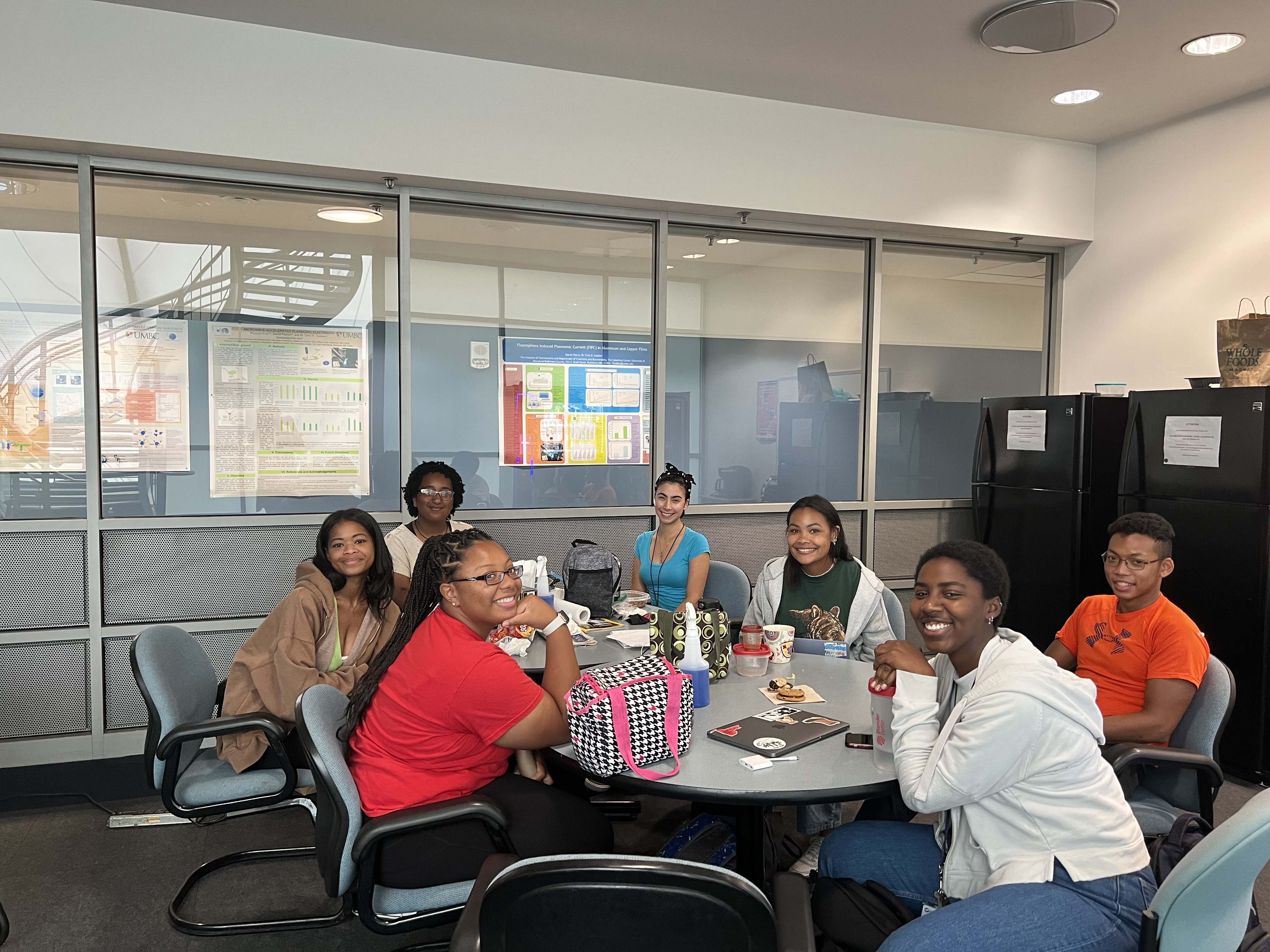
It was Friday before we knew it, and time to check back in with Keith Snipes. To jog your memory, Keith met with the interns at the beginning of the summer. Keith encouraged each intern to research and present a scientist who inspires them. You can look back through the list of inspirational scientists here. This week Keith returned to get the interns talking. They covered a wide range of topics from messiah leaders to local news to racism and religion. The conversations were stimulating and unreserved.
When discussing racism, Keith explained his belief that most people don’t understand what racism is. He argued that racism must be undergirded by some type of power. This led the conversation down a new path, who has the power to change the system?
Keith raised the concept of “messiah leadership” and used Dr. Martin Luther King as an example. He explained that Dr. King did not want to be a civil rights leader but rather a medical doctor or a lawyer. How unfair it was that Dr. King had to set aside this dream for another, more famous one. However, Keith explained, despite this injustice and his own fear, “Dr. King became an incredible leader without whom we may not be sitting here today”.
However, is it unfair to expect messiah leaders to be the solution? Through some of the interns' eyes, it cannot be expected that those who live with the impacts of racism must be the ones to solve it. We must expect those in positions of privilege and power to support, share, and carry out this work. Here, the discussion returned to the power of education and voting. They discussed the importance of educating all people and encouraging them to have conversations like this one. Also important is the ability for every person to educate themselves and vote for candidates who support their rights and beliefs.
To close out the session Keith had the interns watch an interview with author Toni Morrison, where she explains “what racism is”. Please see the video below if you would like to watch as well! Thank you for joining us this week, come back soon!
Week 8: Game, Set, Match
Well, Week 8 has come and gone, meaning there’s only one week left of IMET’s Summer Internship. Next Friday, the interns will present their research during IMET’s “Research Day.” With the end drawing near, the interns kicked into high gear. With the assistance of their mentors and lab mates, the students have been working hard to conclude their research and create their final presentations. We can’t wait to see all they have learned in the lab!
Concepts mastered in the Friday workshops may also come in handy for our interns during their presentations. Maybe we’ll get to hear a great “ABT” statement, from Week 3’s work session with IAN; or we’ll see a beautiful conceptual diagram, from Week 4; maybe we’ll even get to experience some scientific poetry, from the workshop with Dr. Kate Gillespie! We are amazed at the dedication, enthusiasm, and persistence the interns have shown this year. Hard at work in the labs this week, it is clear the interns have not only learned but mastered many lab methods.
Julia Moya gave us a quick rundown of what she has been doing in the lab. Julia is collecting data on the biodiversity of invertebrates in the Patapsco River. To do this, Julia has learned how to perform DNA extractions and PCR tests. This may mean nothing to you too, so Julia broke it down for us. After taking samples from sessile communities in the Patapsco River she grinds them down into a sample “smoothie”. To extract DNA from this substance, Julia uses a filter. This filter removes proteins and other unnecessary materials, leaving behind just DNA. But remember, this isn't one organism's genetic material but many’s! Also, all of the DNA collected may not be coming from invertebrates alone. The process she uses will single out DNA from invertebrates, fungi, and other higher organisms, but will not reveal genetic material coming from bacteria. In order to reveal DNA sequences of the invertebrates, Julia performs Polymerase chain reaction (PCR) in a tiny test tube. This makes millions of copies of a piece of the genome called COX1. COX1 can be found in all cellular organism genomes. Similar to the barcode on your groceries, when amplified this genetic segment is able to tell you more about where it came from, by comparison to a massive database of known DNA sequences. Julia pulls out all the DNA with COX1 and passes it along to Sabeena Nazar in IMET’s BAS Lab where the DNA is sequenced. Julia is then able to use these sequences to identify which invertebrates’ DNA she has collected.
How amazing is that? It is truly incredible how much these interns have learned this summer! This week was not all work though, the interns fit in a lot of much deserved fun this week. And when I say fun, I mostly mean FOOD! It was Baltimore’s restaurant week and our interns did not miss out! You may or may not have heard the saying, “phone eats first”, but in this case we're sure glad it did! Look at these amazing photos of the meal Emma Yockman shared with her lab mates at Petit Louis Bistro!
Some of the other interns went out to lunch with their mentors at Lebanese Taverna, a gorgeous 10 minute walk from IMET! And if that wasn’t enough food and fun, Friday was IMET’s yearly picnic.
Before heading off to the picnic, the interns met with Keith Snipes one final time! Last week, Keith had asked the interns to prepare a letter to their future selves. Only Julia and Libby had prepared responses. Julia wrote that she reminded her future self of the importance of acknowledging her accomplishments and being more present for and accepting of herself. Libby shared that she wrote a letter to herself every year and that it helped her stay authentic and allowed her to live free from the expectations and interpretations of her development imposed by others. This opened up a floodgate of discussion of the toxic pressures exerted on teenagers during their high school years by their schools, parents and peers. Intense, unrelenting pressure to achieve in so-called "high achievement schools" can erode the students' self esteem and often leads schools to devalue those who aren't in the top tier of academic achievement and/or success at extracurricular activities, such as varsity sports. After discussing these responses, the interns headed over to Gunpowder Falls State Park to meet their colleagues!
As described last week, IMET’s picnic is not only about good food but good competition. The picnic is also an institute-wide volleyball tournament. The interns “elite” strategy did not disappoint! We hate to admit it, but their volleyball skills had some of us out there feeling a little old! The picnic was held at a pavilion in Gunpowder Falls State Park. It was wonderful to get outside and enjoy the fresh air. The interns were able to connect with IMET colleagues and friends over great food and friendly competition, what more could you ask for? To close off a truly wonderful week, we wanted to share some of the fun with you! Check out the photos below, to get a taste of the picnic!
Week 9: Happy IMET You
ANDREA WHITE: IDENTIFYING CRUSTINS IN BLUE CRABS | MENTORS: DR. SOOK CHUNG AND DR. TSETSO BACHVAROFF
Andrea’s research focused on a crustacean close to all Baltimorean hearts, the blue crab. The blue crab is ecologically and economically important throughout the Chesapeake Bay and the wider world. Andrea’s research focused on the role of crustins in blue crab reproduction. Crustins are antimicrobial peptides present in many crustaceans. These antimicrobial peptides are made up of a series of amino acids and function as a first line of defense against potential infections. In order to understand if crustins play a role in blue crab reproduction, Andrea first analyzed their nucleotide and amino acid sequences. She found that within the blue crab genome there are multiple copies of the gene that codes for crustin. She also compared the amino acid sequence of crustin in blue crab to crustin in other crustaceans and found that 12 of the sequences analyzed were perfectly aligned. Andrea’s research indicated that the presence of crustin is important, as it was maintained through years of evolution and natural selection.
LIBBY GILMORE: THE EFFECT OF ARAGONITE AMENDMENTS ON MICROBIAL COMMUNITY DIVERSITY | MENTORS: DR. ERNEST WILLIAMS AND DR. ALLEN PLACE
JACQUELINE ROGERS: DEAD-END KNOCKOUT AND PRIMORDIAL GERM CELL DEVELOPMENT| MENTOR: DR. TEN-TSAO WONG
EMMA YOCKMAN: ISOLATION AND CHARACTERIZATION OF MICROALGAE IN THE INNER HARBOR| MENTORS: DR. FENG CHEN & JEFFERY JIAO
Makayla’s project focused on the removal of dinoflagellates from Baltimore’s Harbor. She explained that dinoflagellates are photosynthetic organisms that act as primary producers in aquatic habitats. However, dinoflagellates are not always beneficial, some species can cause harmful algal blooms. These algal blooms can produce toxic or harmful effects to people, fish, aquatic mammals, and birds. Dinoflagellates associated with these blooms are known to exist in Baltimore’s Inner Harbor. Makayla’s project explored the possibility of using a small species of naturally occurring mussels to filter these dinoflagellates from the water. From two locations in the Inner Harbor, Makayla collected water samples and mussels. After extracting the DNA, she ran a qPCR to quantify and compare the dinoflagellate DNA found in both the water and the mussels. Makayla’s research found that the dinoflagellate, Prorocentrum minimum’s DNA was most abundant in the mussel samples. Makayla hypothesized that increasing the presence of mussels in the harbor may be beneficial in the reduction of harmful algal blooms, specifically mahogany tides caused by Prorocentrum minimum.
ZOMA ATNAFOU: EXPLORING ANTIBIOTIC RESISTANCE OF BACTERIA FOUND IN MUSSELS & WATER OF BALTIMORE HARBOR| MENTORS: DR. ERIC SCHOTT & DR. KHALED MOHAMMED-GEBA, ABDUL ADARANIJO
Zoma explained that, due to aging infrastructure, the bacterial presence in Baltimore’s harbor is increasing. As bacteria increases, there is growing concern over how many of these bacteria have become resistant to antibiotics. Zoma’s research examined the presence of antibiotic resistant bacteria in mussels from the harbor. Mussels are filter feeders, meaning they have the ability to remove harmful bacteria from the water. Zoma collected mussels from two sampling sites near IMET. After grinding up the mussel samples, she incubated the puree in culture medium. This allowed the bacteria found in the samples to grow and multiply, giving Zoma a larger sample to study. In order to determine if any of these bacteria were antibiotic resistant, Zoma plated them on agar containing antibiotics. Any bacteria that grew in the presence of the antibiotics was then cultured in a broth of antibiotic and plated again. Whatever bacteria survived this process and were able to grow on the plate were determined antibiotic resistant. Using PCR Zoma amplified the DNA of these bacteria, sent them out for sequencing, and identified their sequences using genetic databases. Zoma discovered that the antibiotic resistant strains of bacteria were related to those that cause sepsis, meningitis, and pneumonia. As these bacteria were discovered inside mussels collected from the harbor we know that mussels in the Inner Harbor do contain antibiotic resistant bacteria. Further research is needed to determine if these bacteria were filtered from the water by the mussels for food or were actually infecting the mussels.
JULIA MOYA: BIODIVERSITY OF INVERTEBRATES IN PATAPSCO RIVER DURING SUMMER 2019 | MENTORS: DR. ERIC SCHOTT & DR. TSETSO BACHVAROFF
Thank you!
- Our funders, whose support makes this program possible: Mary Catherine Bunting, the Venable Foundation, the Charles A. and Lois H. Miller Foundation, and the National Science Foundation
- The internship program faculty advisors: Dr. Rosemary Jagus, Dr. Eric Schott, and Dr. Tsvetan Bachvaroff
- IMET and UMCES Staff: Dr. Russell Hill, Monica Gellene, Sarah Hughes, Samantha Heyn, and Sam Sibanda
- UMCES Integration and Application Network Staff
- The workshop leaders, Keith Snipes and Dr. Kathleen Gillespie
- All our Friday guest speakers


